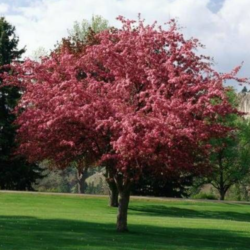Description
Key Features:
Size & Growth: The Bur Oak is a large deciduous tree that typically grows to a height of 50 to 60 feet with a spread of 50 to 60 feet. It features a broad, rounded canopy and a strong, sturdy trunk, making it an excellent choice for creating shade and focal points in large gardens or landscapes.
Foliage: The tree’s leaves are large and deeply lobed, with a distinctive shape that gives the Bur Oak its characteristic appearance. In spring and summer, the leaves are a rich green, turning a golden to russet brown in the fall before dropping.
Acorns: Produces large acorns with unique fringed caps, which are an important food source for wildlife. The acorns mature in the fall and are an attractive feature of the tree.
Bark: The bark of the Bur Oak is grayish-brown and deeply ridged, adding texture and visual interest to the tree’s trunk and branches.
Growth Rate: Moderate growth rate. While it may take several years to reach full size, the Bur Oak is known for its longevity and resilience.
Disease Resistance: Known for its robustness and resistance to common oak diseases, such as oak wilt and powdery mildew. Its hardy nature makes it a reliable choice for various environmental conditions.
Soil & Light Requirements: Prefers well-drained soil and thrives in full sun to partial shade. It is adaptable to a range of soil types, including clay, loam, and sandy soils. The Bur Oak is particularly tolerant of drought and urban conditions.
Care Instructions: Requires minimal maintenance once established. Regular watering during dry periods helps the tree establish a strong root system. Pruning is typically only necessary to remove any dead or damaged branches or to shape the tree as needed.
Uses:
Shade Tree: Ideal for providing shade and cooling in large garden spaces, parks, and lawns. Its broad canopy offers extensive coverage and a cooling effect.
Ornamental: Adds a striking and stately presence to any landscape design. The tree’s large size, distinctive leaves, and unique acorns make it a focal point in gardens and natural settings.
Wildlife Habitat: Provides valuable habitat and food sources for wildlife, including birds, squirrels, and other small animals. The acorns and dense canopy offer shelter and sustenance.
Planting & Maintenance:
Planting: Choose a location with well-drained soil and full sun to partial shade. Dig a hole that is twice the width of the root ball and place the tree at the same depth it was growing in the container. Space multiple trees at least 40 to 50 feet apart to accommodate their mature spread.
Watering: Water thoroughly after planting and during dry periods to help establish the tree. Once established, the Bur Oak is relatively drought-tolerant.
Pruning: Minimal pruning is required. Remove any dead or damaged branches as needed. Prune in late winter or early spring before new growth begins to shape the tree and maintain its health.
Add the grandeur and resilience of the Bur Oak to your landscape. Its impressive size, distinctive appearance, and low-maintenance requirements make it a valuable and enduring addition to any garden or park.





